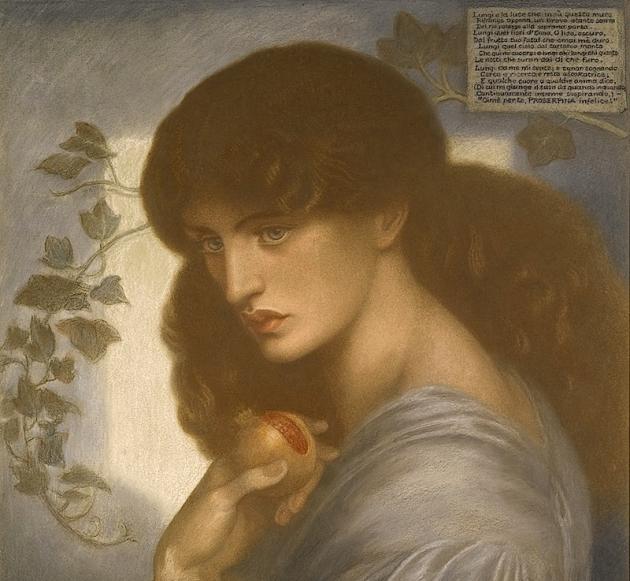Sotheby’s is to offer an iconic Pre-Raphaelite masterpiece by Dante Gabriel Rossetti in their 19 November 2013 London sale of British & Irish Art. The version of Proserpine, in coloured chalks is one of the most internationally recognisable images of the nineteenth century. Proserpine by Dante Gabriel Rossetti (1828-1882) has come to represent the artist in his final and fullest identity, and of all his subjects that of Proserpine occupies a seminal position in the artist’s oeuvre. The re-emergence at Sotheby’s of a version in coloured chalks is concurrent with the major Pre-Raphaelites exhibition taking place at the Pushkin Museum of Fine Arts in Moscow – the international show first staged by Tate Britain last year and held earlier this year at the National Gallery of Art in Washington DC.
Rossetti considered Proserpine the most beautiful of all his inventions and the various versions he produced are crucial to our understanding of his art. It is also the picture in which Rossetti wove his most allegorical symbolism. The model for the work, Jane Morris – wife of William Morris – became his inspiration and muse. The present version, formerly in the collection of William Graham, Rossetti’s most loyal and devoted patron, comes to the market for the first time in over forty years, with an estimate of £1.2 – 1.8 million.
Simon Toll, Sotheby’s British & Irish Art Specialist, commented: “Dante Gabriel Rossetti’s haunting image of Proserpine is one of the defining images of European art – instantly recognisable and representing the artist at the zenith of his originality. In many ways it stands apart from much of the art created by Rossetti’s contemporaries, as something new and otherworldly that was unlike anything else that had been seen before it. This is one of the most important British pictures to be seen on the auction market in many years, having only been in three collections since it was created in 1880.”
The drawing was begun in 1878 and clearly occupied Rossetti for some time as he did not date it until 1880, when it was acquired by William Graham, an MP for Glasgow who owned thirty-seven pictures by Rossetti. The picture was last seen on the art market in 1970 when it was sold by the Stone Gallery in Newcastle-upon-Tyne. Amongst the admirers of Rossetti’s art was L.S. Lowry, who owned one of the oil versions of Proserpine.
Subjects from classical mythology had become increasingly important stimuli for Rossetti. He plundered its world to produce his own interpretations. As Rossetti worked on the first painting of Proserpine, he composed a sonnet as an accompaniment. This is given in its Italian form on a cartellino in the two principal oil versions as well as in the present drawing. The drawing depicts Proserpine (or Persephone, to use her Greek name), daughter of Zeus, in a shadowed corner of her subterranean palace. In her elegant pale hands she holds a pomegranate, her consumption of its seeds condemning her to stay for half of each year in the underworld with her abductor Pluto. The spectator is placed in the position of Pluto himself, catching Proserpine moments after she has tasted the succulent fruit, with the juice staining her lips. Her gaze has become an enigma of femininity, her symbolic beauty transcending the age in which Rossetti created her. As Queen of the Underworld, Proserpine personifies winter, when nature is held captive by frost and ice. She also represents life, through the golden glow of her flesh and the warmth of her lips, and female virginity, the fruit revealing itself to have been consumed a vivid signifier of sexuality. The delicious yet forbidden pomegranate reflects the contradictions of illicit temptation.
To Rossetti, Proserpine symbolises love in grief. He had turned to Jane Morris in the middle of the 1860s for spiritual succour, following his love affair with Fanny Cornforth, his marriage to Elizabeth Siddal and his wife’s tragic death. He became enamoured with her extraordinary physical appearance and personality, and her role as his inspiration and muse remained undiminished until his death. It is unknown whether they were lovers in a physical sense, but their relationship intensified to such a degree that Jane announced she could not continue it at the level Rossetti required, and asked him to agree that instructions should be given in his will that the letters they had exchanged were to be destroyed on his death.
The choice of a mythological subject in which a woman is condemned to endure long periods locked in frigid interment and only periodically allowed to enjoy warmth and comfort cannot have been other than a deliberate reference to the refuge Jane took with Rossetti from the hollow constraints of her marriage and the circumstances of their relationship. This must have been resonantly poignant to them both.
The successive versions of Proserpine by Rossetti show Jane Morris tormented by grief at her fate. Her right hand rests on the wrist of her left, in what appears to be an attempt to restrain herself from tasting the fateful fruit. Both the sonnet and image emphasise a sense of separation and remoteness; symbols of memory, such is the tendril of ivy and lamp, lend meaning. The distress that Rossetti’s love for Jane Morris brought him colours his interpretation of Proserpine, and ultimately the work is as much to do with his own sense of isolation and loss as hers.
The British & Irish Art sale takes place On 19 November 2013, Sotheby’s London Auction Rooms
Photo: Proserpine (Detail Top/Full Below) by Dante Gabriel Rossetti (1828-1882) courtesy Sotheby’s


